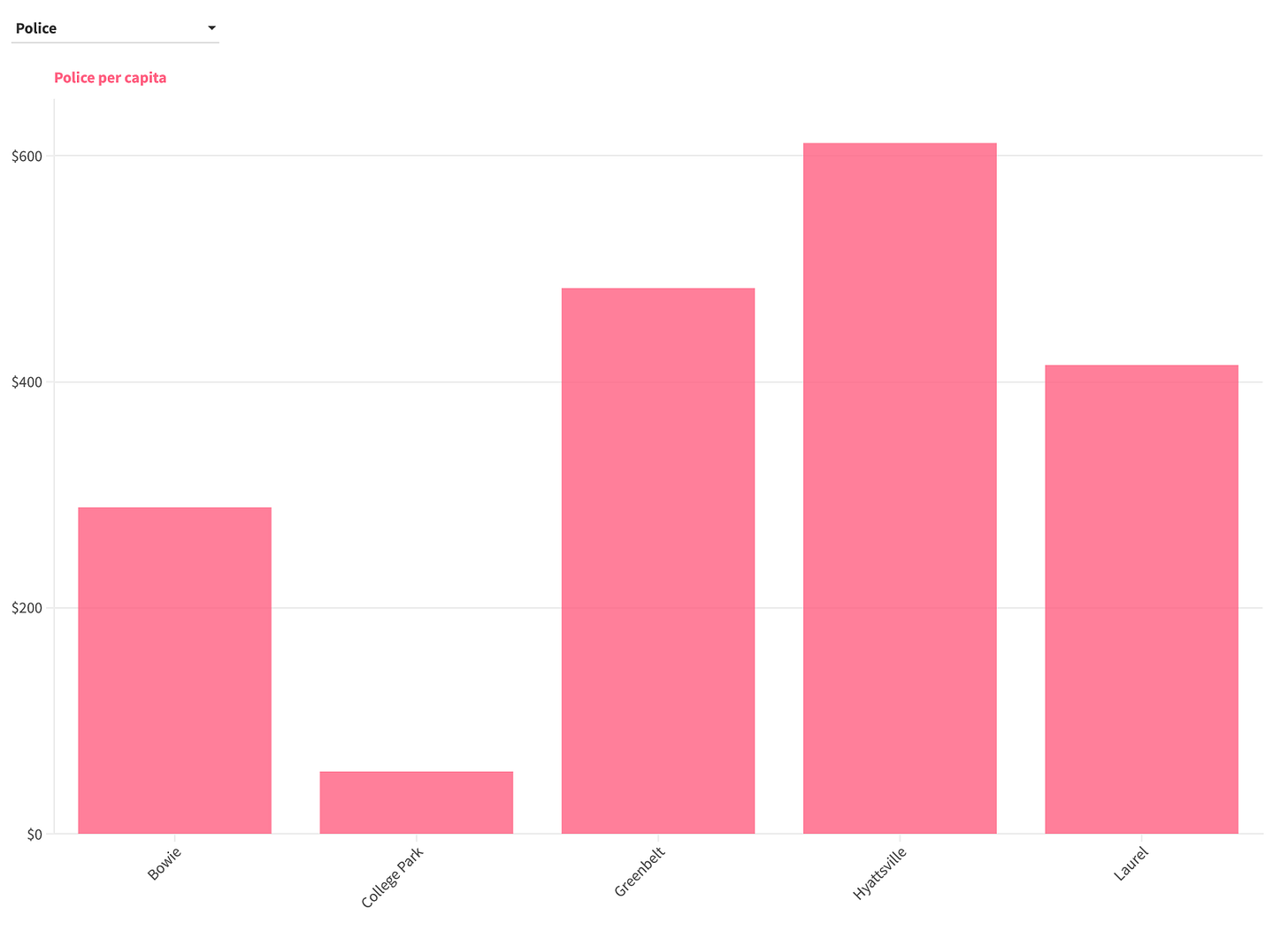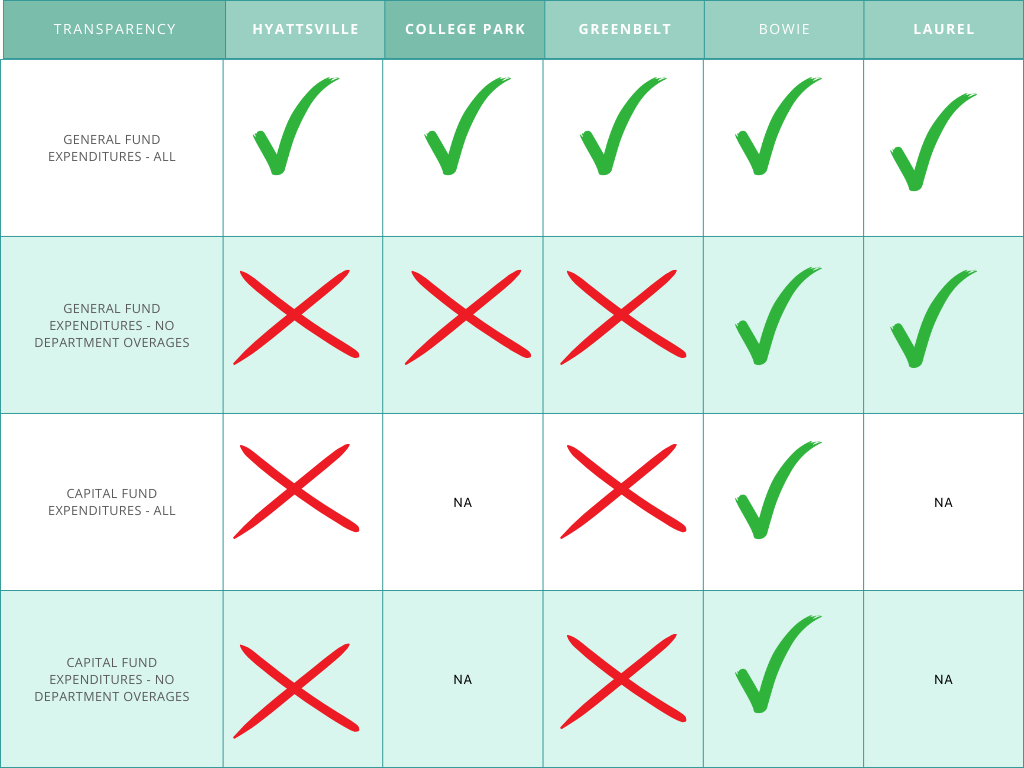Transparency on transparency: How Hyattsville stacks up
The annual budget process is a typical resident's best look at city finances. How well do the documents disclose what is going on? Are local governments complying with their budgets?
It’s the end of budget season and the five largest municipalities in Prince George’s have passed or will likely soon pass their fiscal year 2025 budgets, all in time for the beginning of the new fiscal year on July 1, 2024. Bowie, College Park, Greenbelt, Hyattsville, and Laurel all have property tax bases in excess of $1 billion, making them — wealth-wise — the largest municipalities out of 27 in the county. All three have extensive proposed budgets, clocking in with at least 100 pages to sift through, while Bowie’s is the longest at 384 pages. Route One Finance answers: how else do they compare?
Hyattsville spends the most per capita, with $1,565 in general fund expenditures per resident, though Bowie and Greenbelt are right behind Hyattsville. Bowie is the largest of the five in population, property values, and gross general fund revenues and expenditures. College Park, also in the route 1 corridor, spends the least per capita, though it has the second-largest population. How else are they different?

For most of the municipalities, police and public works are the two largest departments. Hyattsville spends the most per capita on the police department — $611 — 27% more than Greenbelt, the next highest spender. College Park, which has a police contract rather than a standalone department, spends the least per capita.

Bowie, however, spends a bit more per capita on public works than Hyattsville — $402 per resident to Hyattsville’s $380. Both spend quite a bit more than the other three: College Park ($212), Greenbelt ($193), and Laurel ($173).
Transparency: what a reader can learn from the budgets and audits
I looked at five categories of transparency — whether the FY 2023 audit was complete, whether the general fund budget pages showed how much the city had spent in prior years, whether the capital fund budget pages showed how much the city had spent in prior years, whether capital spending was broken down on a project basis, and whether the budget disclosed the capital fund balance.
FY 2023 audits and budgetary compliance
Bowie, College Park, and Greenbelt have all completed their FY 2023 audits, which were due to the state on October 31, 2023. Bowie’s and Greenbelt’s are posted on their website, while College Park’s took a bit more digging. I couldn’t find Laurel’s, and they didn’t respond to emailed questions. Hyattsville hasn’t completed their FY 2022 or FY 2023 audit.
In addition to basic compliance with state law, audited financial statements also show whether or not a city complied with its budget. As the Government Finance Officers Association says, “Adherence to the budget is of paramount importance to the majority of a government's stakeholders” — that is, a lot of people care about whether or not a city is actually complying with its budget.
Most of the cities are doing pretty well complying with their budget. None reported spending more than total approved expenditures in their most recent audit, though Hyattsville, College Park, and Greenbelt all reported going over the allotted amount in some departments. Hyattsville and Greenbelt both overspent their capital fund budget: Hyattsville by $2 million or 24%, Greenbelt by about $250,000 or 18%.
General income and spending from prior years
All five budget documents disclosed how much the cities had earned and spent in previous years for their general funds. This lets readers see how much tax revenues are increasing and how much department spending — such as police and public works — has changed over time. The cities all show this a little differently. Hyattsville, for example, shows spending back to FY 2021, while Laurel only shows back to FY 2023 in its tables. College Park and Greenbelt both provide projected spending through the end of FY 2024 alongside the FY 2024 budget numbers.
Capital income and spending from prior years
Everyone except Hyattsville and Laurel report how much they received and spent out of their capital projects fund for prior years. Residents of Hyattsville don’t learn this information until a few years later, because it's not disclosed in the budget and the audits are late. But it’s important to know whether a city received the capital income it expected to, such as from state funds or debt issuances, and how much a city spent on large, long-term projects. Capital spending often doesn’t receive as much air time in city meetings, and its section of Hyattsville’s budget document is much shorter than the general fund section, but cities actually spend a lot of money building and renovating properties, as well as purchasing vehicles and other large equipment. When capital spending is debt financed, it also affects how much money the city has promised to pay out to creditors in years to come. In the absence of audits, it can also be a clue to whether or not a city is complying with its capital budget.
Bowie, College Park, and Greenbelt all report capital spending and income in the budget document, so readers can compare to prior years.
Project-by-project breakdown of proposed capital spending
Cities also use project budgets to track capital spending, such as the new police headquarters project at 3505 Hamilton in Hyattsville or the Duvall field renovation project in College Park. Everyone except Hyattsville shows how total capital spending will be broken down by project, not just department. College Park, for example, also shows how much has been spent on the project to date and specifically where the funding has come from.
Capital fund balance disclosed
If you want to plan your spending for the next year — really, five years in the case of capital improvements — it helps to know how much you already have in your checking account. College Park, Greenbelt, and Bowie clearly report how much money the cities already have in their capital projects fund, as well as new incoming revenue and expected spending. Laurel sort of reports this, because they say how much money they want to reauthorize from last year ($22.6 million) and how much they’d like in new funding ($6 million). But in the absence of a clear statement or an FY 2023 audit, Laurel’s budget readers are left mostly to guess and hope that they’re right.
Hyattsville does not report this information at all. In the absence of audited financial statements or unaudited figures presented in the budget document, Hyattsville’s budget readers don’t know how much the city already has (or doesn’t have) in its capital fund. Hyattsville city treasurer Ronald Brooks most recently predicted the FY 2022 audit would be ready by the end of June 2024. Last year, Brooks said the FY 2021 and 2022 audits would be ready by August 2023 after the city council approved a new audit contract with Lindsey + Associates in December 2022. The FY 2021 audit was reissued in April 2024.
This article is sent free to all subscribers, but if you appreciate it, I invite you to upgrade to a paid subscription, which offsets my childcare costs to dive through over about 1,000 pages of budget documents.




